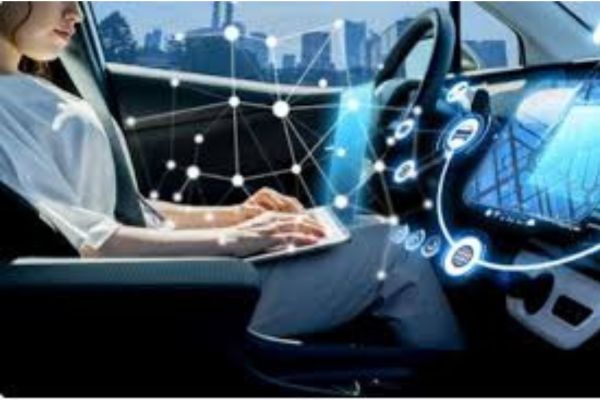Imagine a bustling city where self-driving cars glide seamlessly through traffic, autonomous trucks deliver goods with precision, and delivery drones zip overhead—all orchestrated by advanced artificial intelligence (AI). Autonomous vehicles (AVs) are no longer a futuristic fantasy but a transformative force reshaping global transportation, commerce, and education.
The global race toward AVs is accelerating rapidly, but in India, the journey is far more complex. As countries like the United States, China, and Germany test driverless cars on public roads, India finds itself grappling with fundamental questions: Is the country ready for autonomous vehicles, and what will it take to make them a reality?
In India, as of April 2025, AVs are in the early stages of development, with companies like Minus Zero, Swaayatt Robots, Flux Auto, and Flo Mobility working on solutions tailored to India’s chaotic road conditions. Major players like Tata Motors have patented a Level 5 AV model, Tata Yu, showing promise, but official road deployment is restricted due to infrastructure and regulatory hurdles. This article explores every aspect of AV revolution:
Understanding Autonomous Vehicles
Autonomous vehicles, often called self-driving cars, trucks, or buses, navigate roads with minimal or no human intervention. They rely on a sophisticated blend of technologies:
- Sensors: LIDAR, radar, and cameras detect obstacles, lane markings, and traffic signals.
- Artificial Intelligence: AI processes real-time data to make decisions on steering, braking, and acceleration.
- Connectivity: Vehicle-to-everything (V2X) communication enables interaction with other vehicles, infrastructure, and cloud systems.
- High-Definition Maps: Precise maps guide navigation and anticipate road conditions.
The Society of Automotive Engineers (SAE) defines six levels of automation, from Level 0 (no automation) to Level 5 (full automation, no human input). Most AVs today operate at Level 2 or 3, offering partial automation like adaptive cruise control and lane-keeping. Level 4 systems, capable of handling complex urban environments, are being tested by companies like Waymo, while Level 5 remains a long-term goal.
Educating the next generation about these technologies is critical. Schools and universities must integrate AV concepts—AI, robotics, and data science—into STEM curricula to equip students for a rapidly evolving industry. This educational foundation will drive innovation and ensure a skilled workforce to support AV growth.
Global Autonomous Vehicle Market Size
The global AV market is on a steep upward trajectory. Valued at USD 207.38 billion in 2024, it is projected to reach USD 4450.34 billion by 2034, growing at a compound annual growth rate (CAGR) of 36.3%. North America leads, driven by robust technological infrastructure and investments from companies like Waymo and Tesla. Asia-Pacific follows closely, with China and Japan pushing for self-driving technology integration in smart cities. Europe emphasizes safety and regulatory frameworks, contributing to steady growth. Key drivers include advancements in AI, rising demand for safer roads, and urban mobility challenges, with luxury cars (Level 1 and 2) and robotaxis fueling early adoption in emerging economies.
India Autonomous Vehicle Market Size
India’s AV market, while nascent, is poised for significant growth. Valued at USD 2.6 billion in 2024, it is expected to reach USD 23.3 billion by 2033, with a CAGR of 24.3%. Urbanization, a burgeoning middle class, and government support for electric vehicles (EVs) and smart mobility are key catalysts. However, challenges like inadequate road infrastructure, regulatory gaps, and affordability persist. Indian startups like Minus Zero are innovating, and global players like Tata Motors are exploring AV integration with EVs. The Motor Vehicles (Amendment) Act 2019 has enabled AV testing, signaling India’s ambition to join the global race, though full autonomy remains a decade away due to infrastructure and traffic complexities.
AVs and International Trade
AVs are reshaping global trade by enhancing efficiency and creating new markets:
·Supply Chain Transformation: Autonomous trucks and drones optimize logistics, reducing delivery times and costs. This efficiency strengthens global supply chains, enabling faster trade of goods.
·Manufacturing and Exports: The AV ecosystem—sensors, chips, software—drives trade in high-tech components. Countries like the U.S., China, and Germany lead exports, while India emerges as a manufacturing hub, leveraging its “Make in India” initiative.
·Regulatory Harmonization: Global standards for AV safety, data privacy, and cybersecurity are critical for cross-border operations. Trade agreements must address these to facilitate seamless AV deployment.
Global Innovations and Case Studies
The AV landscape is vibrant:
- United State: Waymo’s Level 4 robotaxis operate in Phoenix, while Tesla advances Full Self-Driving.
- China: Baidu’s Apollo platform leads Asia, with AVs in Beijing.
- EU: Germany and the UK prioritize safety, testing Level 4 systems.
- India: Minus Zero develops AV software, and Tata explores EV-AV synergies.
A Vision Fueled by Innovation
The potential of autonomous vehicles in India is undeniable. AVs could revolutionize mobility by reducing traffic congestion, cutting down road accidents, and offering new transport solutions for the elderly and differently-abled. With India’s push toward a $5 trillion economy and its Smart Cities Mission, driverless technology could play a key role in shaping future urban mobility.
Major players like Tata Elxsi, Mahindra, and even startups are investing in autonomous driving technologies. Global tech giants such as Google’s Waymo and Tesla have expressed interest in the Indian market, sensing the long-term potential despite current hurdles.
Roadblocks on the Horizon in India
Several challenges impede the progress of AVs in India, as identified in recent analyses:
- India’s real-world conditions pose significant challenges to the adoption of AVs. Unlike in Western nations where traffic systems are more disciplined, Indian roads are unpredictable, crowded with pedestrians, bicycles, stray animals, and vehicles often ignoring traffic rules.
- Infrastructure remains another stumbling block. The lack of well-marked lanes, standardized road signs, and high-definition mapping technologies means AVs would struggle to navigate effectively. Additionally, weather conditions such as monsoons, poor visibility, and dust could impact sensor performance.
- Legal and regulatory frameworks for autonomous vehicles are still in their infancy in India. There is no dedicated legislation addressing issues like liability in case of accidents involving AVs, insurance norms, or cybersecurity threats.
- There is also skepticism among the public. Trust in autonomous technology is low, with concerns over safety, job losses in the transport sector, and ethical dilemmas regarding decision-making in critical situations.
The impact on employment, particularly for millions who depend on driving for their livelihoods, is a pressing socio-economic concern. Policymakers would need to address these issues with reskilling programs and phased implementation strategies.
Role of Education and Skilling
As the automobile industry transitions towards electric and autonomous technologies, education and skilling play a critical role in preparing the workforce for future demands. Traditional engineering curricula must be reoriented to include emerging domains such as artificial intelligence, robotics, data analytics, cybersecurity, and vehicular communication systems.
Automotive Skills Development Council (ASDC) is pivotal in preparing India’s workforce for the automobile industry. Established under the Ministry of Skill Development and Entrepreneurship, ASDC offers certification and training programs in automotive technologies. As autonomous vehicles gain traction, ASDC will provide relevant skill development and training to equip workers for emerging roles in the AV ecosystem.
ASDC is closely tracking industry trends and upgrades to design future-ready skill development programs that address these evolving requirements. Its aim is to ensure that India’s workforce remains relevant, adaptable, and well-equipped to take on emerging roles in the autonomous mobility ecosystem.
Job Opportunities in the AV Industry
The rise of AVs is creating a diverse ecosystem of job opportunities, blending traditional automotive expertise with cutting-edge technology. Key roles include:
- Software Engineers (AI and Machine Learning): Develop algorithms for AV perception, navigation, and decision-making.
- Sensor Technicians: Maintain and calibrate LIDAR, radar, and cameras. In India, salaries range from INR 4–8 lakh annually.
- Cybersecurity Specialists: Protect AVs from hacking, critical as vehicles become connected. Global demand has risen 668% since 2015.
- Data Analysts: Process high-definition maps and traffic data to optimize AV performance. Salaries in India: INR 8–12 lakh.
- Field Service Technicians: Test and operate AV systems, requiring electromechanical skills.
- Robotics Programmers: Design automation for AV manufacturing and maintenance, a growing field in India.
- Teledrivers: Operate vehicles remotely, a hybrid role emerging with companies like Vay.
Globally, companies like Waymo and Tesla seek interdisciplinary talent, fostering collaboration among engineers, data scientists, and policy experts. As AV fleets grow, demand for operations managers and infrastructure developers will also surge, particularly in smart cities.
Way Forward
Despite the challenges, the long-term future of autonomous vehicles in India remains promising. Industry experts suggest starting with controlled environments — such as university campuses, tech parks, and industrial zones — where AVs could operate with minimal human interaction.
Pilot programs, better data sharing, investment in infrastructure upgrades, and clear regulatory policies will be crucial. Partnerships between government, industry, and academia can also help create a roadmap tailored to India’s unique needs.
While fully autonomous cars on Indian roads may still be a distant dream, semi-autonomous features like lane-keeping assist, adaptive cruise control, and automatic braking are already making inroads through premium vehicle models.

Mr. Arindam Lahiri, CEO Automotive Skills Development Council














